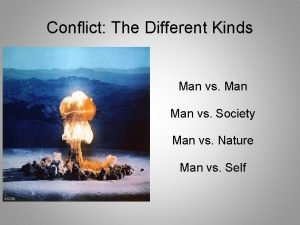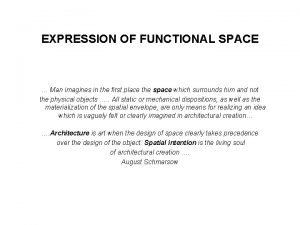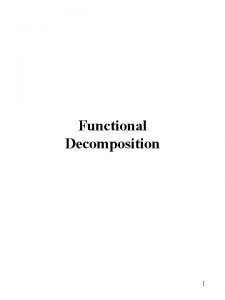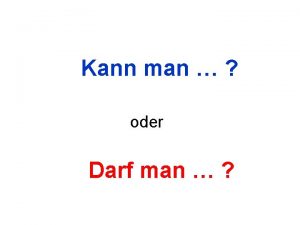EXPRESSION OF FUNCTIONAL SPACE Man imagines in the







































- Slides: 39

EXPRESSION OF FUNCTIONAL SPACE … Man imagines in the first place the space which surrounds him and not the physical objects …. . All static or mechanical dispositions, as well as the materialization of the spatial envelope, are only means for realizing an idea which is vaguely felt or clearly imagined in architectural creation… …. Architecture is art when the design of space clearly takes precedence over the design of the object. Spatial intention is the living soul of architectural creation …. August Schmarsow

DESCRIPTIVE REPRESENTATION OF A DESIGN PROCESS 2

EXPRESSION OF FUNCTIONAL SPACE 1. About the Planning Phase in Design 2. About the Generation Phase in Design 3. About the Evaluation Phase in Design

1. About the Planning Phase in Design 1. 1. Gathering Data: About the Context: (The Site) 1. 1. 1. The Micro World: The Inner Environment 1. 1. Dimensions and Shape of the Site 1. 1. 1. 2. Microclimate: Sun and Wind Incidence Among others: topography 1. 1. 2. The Mega World: The Outer Environment 1. 1. 2. 1. The Access to the Site 1. 1. 2. 2. The View Among others: the spirit of the place “Genius Loci” 1. 2. Establishing Design Intentions or Goals 1. 2. 1. Utilitarian Purpose 1. 2. 2. Formal/Spatial Aesthetics: Balance Between Exterior Form / Interior Space 1. 3. Inferring a Prime Design Idea

1. About the Planning Phase in Design 1. 1. GATHERING DATA: REQUIREMENTS AND CONSTRAINTS

1. About the Planning Phase in Design 1. 1. Gathering Data: The Context (The Site) 1. 1. 1. The Micro World: The Inner Environment

1. About the Planning Phase in Design 1. 1. Gathering Data: The Context (The Site) 1. 1. 1. The Micro World: The Inner Environment

1. About the Planning Phase in Design 1. 1. Gathering Data: The Context (The Site) 1. 2. 1. The Mega World: The Outer Environment

1. About the Planning Phase in Design 1. 1. Gathering Data: The Context (The Site) 1. 2. 1. The Mega World: The Outer Environment

1. About the Planning Phase in Design 1. 2. Establishing Design Intentions or Goals 1. 2. 1. UTILITARIAN PURPOSE

1. About the Planning Phase in Design 1. 2. Establishing Design Intentions or Goals 1. 2. 2. FORMAL / SPATIAL AESTHETICS: Balance Between Exterior Form / Interior Space

1. About the Planning Phase in Design 1. 2. Establishing Design Intentions or Goals 1. 2. 2. MORE ABOUT FORMAL / SPATIAL AESTHETICS: Balance Between Exterior Form /Interior Space

1. About the Planning Phase in Design 1. 3. INFERRING A PRIME DESIGN IDEA: USING METAPHORS WITH A HUMANISTIC APPROACH

1. About the Planning Phase in Design 1. 3. INFERRING A PRIME DESIGN IDEA: USING METAPHORS WITH A HUMANISTIC APPROACH

2. About the Generation Phase in Design a. Generation of the parti: designing the conceptual organization b. Identifying the design elements: enclosure and space (solids and voids) c. Fitting activities with spaces: study of proportions and human scale d. Applying organizing principles e. Implementing design manipulations f. Defining formal / spatial relationships and joints 15

3. About the Evaluation Phase in Design 3. 1. Performance Evaluation: Functional Aspects 3. 2. Evaluation of Formal/Spatial Aesthetics 3. 2. 1. Quality of External Form 3. 2. 2. Quality of Spaces 3. 2. 2. 1. The form of interior spaces 3. 2. 2. 2. Depth 3. 2. 2. 3. Density 3. 2. 2. 4. The degree of enclosure in interior spaces 3. 2. 2. 5. The configuration of interior spaces 3. 2. 2. 6. The view 3. 2. 2. 7. The light 16

3. About the Evaluation Phase in design 3. 1. PERFORMANCE EVALUATION : FUNCTIONAL ASPECTS

3. About the Evaluation Phase in design 3. 1. PERFORMANCE EVALUATION : FUNCTIONAL ASPECTS

3. About the Evaluation Phase in design 3. 2. Evaluation of Formal Aesthetics 3. 2. 1. QUALITY OF EXTERNAL FORMS

3. About the Evaluation Phase in design 3. 2. Evaluation of Formal Aesthetics 3. 2. 2. QUALITY OF INTERNAL SPACES

3. About the Evaluation Phase in design 3. 2. Evaluation of Formal Aesthetics 3. 2. 2. MORE ABOUT THE QUALITY OF INTERNAL SPACES

3. About the Evaluation Phase in design 3. 2. Evaluation of Formal Aesthetics 3. 2. 2. QUALITY OF INTERNAL SPACES 3. 2. 2. 4. THE DEGREE OF ENCLOSURE OF INTERIOR SPACES

3. About the Evaluation Phase in design 3. 2. Evaluation of Formal Aesthetics 3. 2. 2. QUALITY OF INTERNAL SPACES 3. 2. 2. 4. MORE ABOUT THE DEGREE OF ENCLOSURE OF INTERIOR SPACES

3. About the Evaluation Phase in design 3. 2. Evaluation of Formal Aesthetics 3. 2. 2. QUALITY OF INTERNAL SPACES 3. 2. 2. 4. MORE ABOUT THE DEGREE OF ENCLOSURE OF INTERIOR SPACES

3. About the Evaluation Phase in design 3. 2. Evaluation of Formal Aesthetics 3. 2. 2. QUALITY OF INTERNAL SPACES 3. 2. 2. 4. MORE ABOUT THE DEGREE OF ENCLOSURE OF INTERIOR SPACES

3. About the Evaluation Phase in design 3. 2. Evaluation of Formal Aesthetics 3. 2. 2. QUALITY OF INTERNAL SPACES 3. 2. 2. 4. MORE ABOUT THE DEGREE OF ENCLOSURE OF INTERIOR SPACES

3. About the Evaluation Phase in design 3. 2. Evaluation of Formal Aesthetics 3. 2. 2. QUALITY OF INTERNAL SPACES 3. 2. 2. 4. MORE ABOUT THE DEGREE OF ENCLOSURE OF INTERIOR SPACES

3. About the Evaluation Phase in design 3. 2. Evaluation of Formal Aesthetics 3. 2. 2. QUALITY OF INTERNAL SPACES 3. 2. 2. 4. MORE ABOUT THE DEGREE OF ENCLOSURE OF INTERIOR SPACES

3. About the Evaluation Phase in design 3. 2. Evaluation of Formal Aesthetics 3. 2. 2. QUALITY OF INTERNAL SPACES 3. 2. 2. 4. MORE ABOUT THE DEGREE OF ENCLOSURE OF INTERIOR SPACES

3. About the Evaluation Phase in design 3. 2. Evaluation of Formal Aesthetics 3. 2. 2. QUALITY OF INTERNAL SPACES 3. 2. 2. 4. MORE ABOUT THE DEGREE OF ENCLOSURE OF INTERIOR SPACES

3. About the Evaluation Phase in design 3. 2. Evaluation of Formal Aesthetics 3. 2. 2. QUALITY OF INTERNAL SPACES 3. 2. 2. 4. MORE ABOUT THE DEGREE OF ENCLOSURE OF INTERIOR SPACES

3. About the Evaluation Phase in design 3. 2. Evaluation of Formal Aesthetics 3. 2. 2. QUALITY OF INTERNAL SPACES 3. 2. 2. 4. MORE ABOUT THE DEGREE OF ENCLOSURE OF INTERIOR SPACES

3. About the Evaluation Phase in design 3. 2. Evaluation of Formal Aesthetics 3. 2. 2. QUALITY OF INTERNAL SPACES 3. 2. 2. 4. MORE ABOUT THE DEGREE OF ENCLOSURE OF INTERIOR SPACES

3. About the Evaluation Phase in design 3. 2. Evaluation of Formal Aesthetics 3. 2. 2. QUALITY OF INTERNAL SPACES 3. 2. 2. 4. MORE ABOUT THE DEGREE OF ENCLOSURE OF INTERIOR SPACES

3. About the Evaluation Phase in design 3. 2. Evaluation of Formal Aesthetics 3. 2. 2. QUALITY OF INTERNAL SPACES 3. 2. 2. 5. THE CONFIGURATION OF INTERIOR SPACES

3. About the Evaluation Phase in design 3. 2. Evaluation of Formal Aesthetics 3. 2. 2. QUALITY OF INTERNAL SPACES 3. 2. 2. 5. MORE ABOUT THE CONFIGURATION OF INTERIOR SPACES

3. About the Evaluation Phase in design 3. 2. Evaluation of Formal Aesthetics 3. 2. 2. QUALITY OF INTERNAL SPACES 3. 2. 2. 5. MORE ABOUT THE CONFIGURATION OF INTERIOR SPACES

3. About the Evaluation Phase in design 3. 2. Evaluation of Formal Aesthetics 3. 2. 2. QUALITY OF INTERNAL SPACES 3. 2. 2. 5. MORE ABOUT THE CONFIGURATION OF INTERIOR SPACES

References • Archetypes in Architecture, Thomas Thiis Evensen, ISBN 019 -520819 -6 • Architecture: Form, Space & Order, Francis Ching, ISBN 0442 -21535 -5 • Elements of Architecture, Pierre Von Meiss, ISBN 0 -74760014 -7 • Ordering Systems: An introduction to Architectural Design, Edward T. White, Architectural Media, University of Arizona. • Principles of Form and Design, Wucius Wong, ISBN 0 -44201405 -8
 Man vs. society
Man vs. society Imaginez que chaque matin une banque
Imaginez que chaque matin une banque Transpalatal arch space maintainer indications
Transpalatal arch space maintainer indications Quadratic formula examples
Quadratic formula examples Non functional plasma enzymes
Non functional plasma enzymes Enzymes in plasma
Enzymes in plasma Functional and non functional
Functional and non functional Expression of space
Expression of space Cartesian space trajectory planning
Cartesian space trajectory planning Space junk the space age began
Space junk the space age began Camera space to world space
Camera space to world space Cartesian space vs joint space
Cartesian space vs joint space World space to screen space
World space to screen space Hình ảnh bộ gõ cơ thể búng tay
Hình ảnh bộ gõ cơ thể búng tay Lp html
Lp html Bổ thể
Bổ thể Tỉ lệ cơ thể trẻ em
Tỉ lệ cơ thể trẻ em Voi kéo gỗ như thế nào
Voi kéo gỗ như thế nào Thang điểm glasgow
Thang điểm glasgow Hát lên người ơi
Hát lên người ơi Các môn thể thao bắt đầu bằng tiếng đua
Các môn thể thao bắt đầu bằng tiếng đua Thế nào là hệ số cao nhất
Thế nào là hệ số cao nhất Các châu lục và đại dương trên thế giới
Các châu lục và đại dương trên thế giới Cong thức tính động năng
Cong thức tính động năng Trời xanh đây là của chúng ta thể thơ
Trời xanh đây là của chúng ta thể thơ Mật thư tọa độ 5x5
Mật thư tọa độ 5x5 101012 bằng
101012 bằng độ dài liên kết
độ dài liên kết Các châu lục và đại dương trên thế giới
Các châu lục và đại dương trên thế giới Thơ thất ngôn tứ tuyệt đường luật
Thơ thất ngôn tứ tuyệt đường luật Quá trình desamine hóa có thể tạo ra
Quá trình desamine hóa có thể tạo ra Một số thể thơ truyền thống
Một số thể thơ truyền thống Cái miệng xinh xinh thế chỉ nói điều hay thôi
Cái miệng xinh xinh thế chỉ nói điều hay thôi Vẽ hình chiếu vuông góc của vật thể sau
Vẽ hình chiếu vuông góc của vật thể sau Nguyên nhân của sự mỏi cơ sinh 8
Nguyên nhân của sự mỏi cơ sinh 8 đặc điểm cơ thể của người tối cổ
đặc điểm cơ thể của người tối cổ V cc cc
V cc cc Vẽ hình chiếu đứng bằng cạnh của vật thể
Vẽ hình chiếu đứng bằng cạnh của vật thể Phối cảnh
Phối cảnh Thẻ vin
Thẻ vin






























































